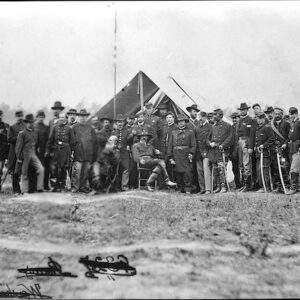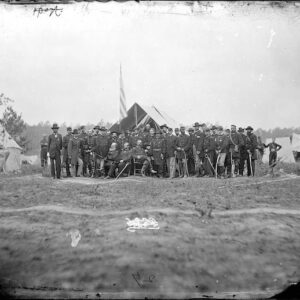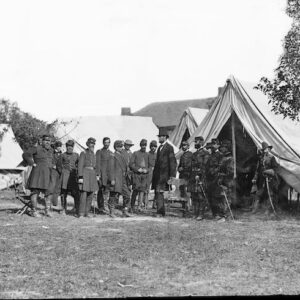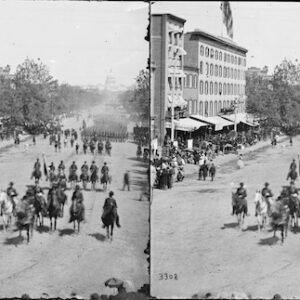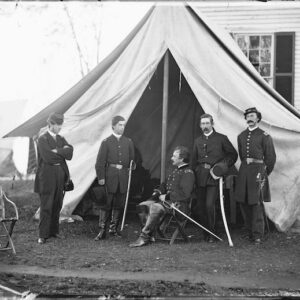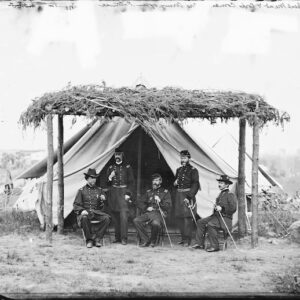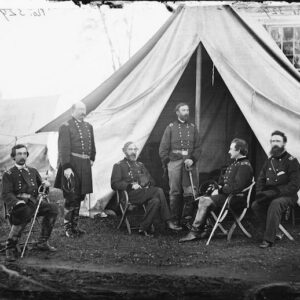Tag: Humphreys (Andrew A.)
 Wikipedia says: Andrew Atkinson Humphreys (November 2, 1810 – December 27, 1883), was a career United States Army officer, civil engineer, and a Union General in the American Civil War. He served in senior positions in the Army of the Potomac, including division command, chief of staff, and corps command, and was Chief Engineer of the U.S. Army.
Wikipedia says: Andrew Atkinson Humphreys (November 2, 1810 – December 27, 1883), was a career United States Army officer, civil engineer, and a Union General in the American Civil War. He served in senior positions in the Army of the Potomac, including division command, chief of staff, and corps command, and was Chief Engineer of the U.S. Army.
…After the outbreak of the Civil War, Humphreys was promoted (August 6, 1861) to major and became chief topographical engineer in Maj. Gen. George B. McClellan’s Army of the Potomac. Humphreys was put in this position because of his achievements in life but also because “those in power at Washington distrusted him because of his intimacy with Jefferson Davis before the war.” Initially involved in planning the defenses of Washington, D.C., by March 1862, he shipped out with McClellan for the Peninsula Campaign. He was promoted to brigadier general of volunteers on April 28 and on September 12 assumed command of the new 3rd Division in the V Corps of the Army of the Potomac. He led the division in a reserve role in the Battle of Antietam. At the Battle of Fredericksburg, his division achieved the farthest advance against fierce Confederate fire from Marye’s Heights, with Humphreys personally commanding from the very front of the line on horseback, while five of his seven staff were shot down. During the battle Humphreys himself had two of horses shot from under him and finding a third he continued to ride, having his clothes pierced but himself unharmed. His corps commander, Brig. Gen. Daniel Butterfield, wrote: “I hardly know how to express my appreciation of the soldierly qualities, the gallantry, and energy displayed by my division commanders, Generals George Sykes, Humphreys, and Charles Griffin.” General Butterfield goes on to talk personally about Humphreys’ actions: “General Humphreys personally led his division in the most gallant manner. His attack was spirited, and worthy of veterans. Made as it was by raw troops, the value of the example set by the division commander can hardly be estimated.” For an officer with little combat experience, he inspired his troops with his personal bravery. Historian Larry Tagg wrote:
… for certain good reasons connected with the effect of what I did upon the spirit of the men and from an invincible repugnance to ride anywhere else, I always rode at the head of my troops.” Lt. Cavada of the general’s staff recalled that just before he took his troops up to the Stone Wall at Fredericksburg, Humphreys had bowed to his staff in his courtly way, “and in the blandest manner remarked, ‘Young gentlemen, I intend to lead this assault; I presume, of course, you will wish to ride with me?'” Since it was put like that, the staff had done so, and five of the seven officers were knocked off their horses. After his men had taken as much as they could stand in front of the Stone Wall on Marye’s Heights, the next brigade coming up the hill saw Humphreys sitting his horse all alone, looking out across the plain, bullets cutting the air all around him. Something about the way the general was taking it pleased them, and they sent up a cheer. Humphreys looked over, surprised, waved his cap to them with a grim smile, and then went riding off into the twilight. In this way Humphreys had turned his first division’s dislike of him into admiration for his heroic leadership …
— Larry Tagg, Generals of Gettysburg
Although respected by his men for his bravery under fire, Humphreys was not well liked by them. In his mid-fifties, they considered him an old man, despite his relatively youthful appearance. His nickname was “Old Goggle Eyes” for his eyeglasses. He was a taskmaster and strict disciplinarian. Charles A. Dana, the Assistant Secretary of War, called him a man of “distinguished and brilliant profanity.”
At the Battle of Chancellorsville, Humphreys’ division was attacked by Colquitt’s brigade on the 3rd day of the battle. On May 23, 1863, Humphreys was transferred to the command of the 2nd Division in the III Corps, under Maj. Gen. Daniel E. Sickles. When Meade assumed command of the Army of the Potomac just before the Battle of Gettysburg, he asked Humphreys to be his chief of staff, replacing Maj. Gen. Daniel Butterfield, who was considered to be too close politically to the previous commander, Maj. Gen. Joseph Hooker. Humphreys declined the opportunity to give up his division command. His new division immediately saw action at Gettysburg where, on July 2, 1863, Sickles insubordinately moved his corps from its assigned defensive position on Cemetery Ridge. Humphreys’ new position was on the Emmitsburg Road, part of a salient directly in the path of the Confederate assault, and it was too long a front for a single division to defend. Assaulted by the division of Maj. Gen. Lafayette McLaws, Humphreys’ three brigades were demolished; Sickles had pulled back Humphrey’s reserve brigade to shore up the neighboring division (Maj. Gen. David B. Birney), which was the first to be attacked. Humphreys put up the best fight that could have been expected and was eventually able to reform his survivors on Cemetery Ridge, but his division and the entire corps were finished as a fighting force.
Humphreys was promoted to major general of volunteers on July 8, 1863, and finally acceded to Meade’s request to serve as his chief of staff; he did not have much of a division left to command. He served in that position through the Bristoe and Mine Run campaigns that fall, and the Overland Campaign and the Siege of Petersburg in 1864. In November 1864, he assumed command of the II Corps, which he led for the rest of the siege and during the pursuit of Gen. Robert E. Lee to Appomattox Court House and surrender. On March 13, 1865, he was breveted brigadier general in the regular army and then on May 26, 1865, he was awarded brevet major general in the regular army for “gallant and meritorious service at the battle of Gettysburg” for the Battle of Sayler’s Creek during Lee’s retreat.
Showing all 10 results
